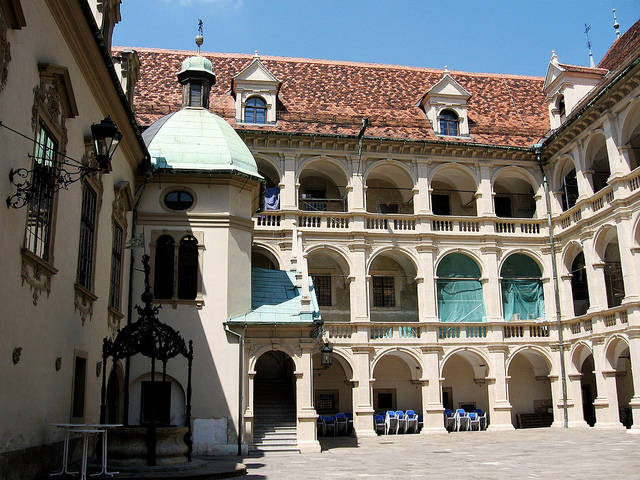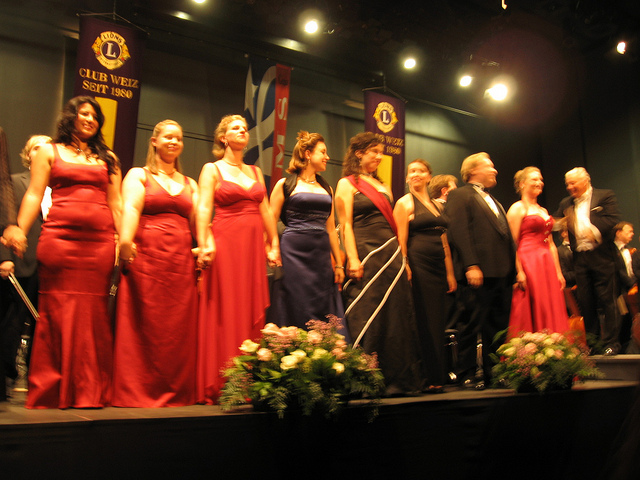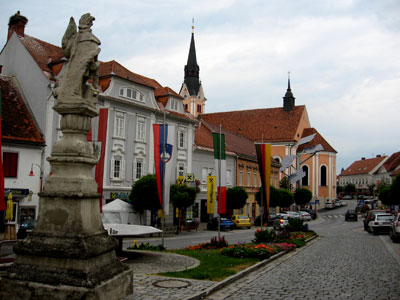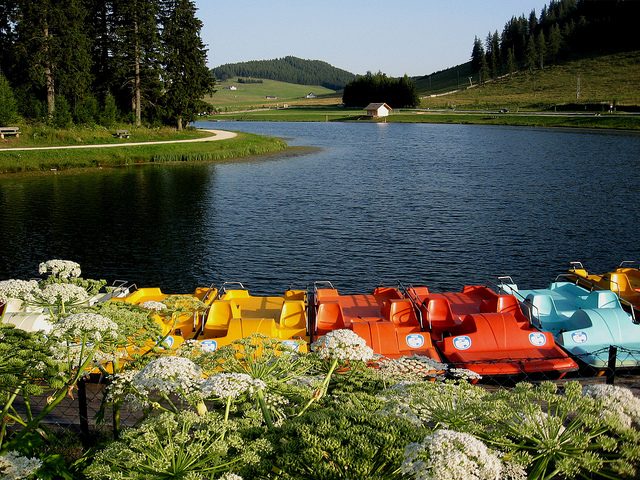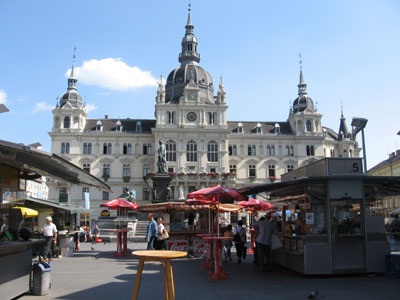Originally, the tower only featured a very large hour hand, and the minute hands that were installed later had to be designed smaller so people would be able to distinguish one from the other. Fortunately, due to the ransom paid in 1809, the tower has survived and we are still able to admire it today while the remainder of the fortification was razed. The tower was also used as a fire alarm bell, as a the “Bell of Poor Sinners” that was rung during executions, and as the bell that announced the closing hours for the local hospitality establishments.

Beautiful inner courtyard
Just below the Uhrturm is a small garden surrounded by flowers which offers a gorgeous view over the city and its Main Square. I started to make my way down from the Schlossberg along the serpentine-like paths in the park and stopped by the entrance to the Schlossbergstollen (Schlossberg Tunnel), part of the tunnel system that is built into the mountain and was used as air raid shelters during the air attacks of World War II. Today you can cross the base of the mountain through this tunnel. At the base I reached the Karmeliterplatz Square. One of the buildings on the north side of the adjacent Sporgasse also features a stunning inner courtyard and I wished I had had more time to explore the hidden treasures of Graz’ secret courtyards.

Wooden carvings at the Edegger-Tax Bakery
I turned left into a street called Hofgasse and stopped at a very unusual building: the Edegger-Tax Bakery, a so-called royal bakery, the oldest such establishment in Graz that dates back to 1569. It stunning 1896 carved wooden portal sets it apart from the surrounding stuccoed houses and during the late 1800 this bakery became an official supplier of Austria’s ruling royal families.

The Grazer Dom (Cathedral)
My walk continued to the Freiheitsplatz (“Liberty Square”) which is the location of Graz’ theatre. Across the street from the Schauspielhaus theatre is the Grazer Dom, a cathedral that dates back to 1438. The south side of this late-Gothic church is adorned with a painting of the three scourges: the Black Plage, war and locusts. Austrian imperial coats of arms as well as those of Styria and Portugal point to the historic aristocratic connections.

Mausoleum of Emperor Francis Ferdinand II
Right next to the Dom is the Mausoleum of Austrian emperor Francis Ferdinand II, one of Austria’s most important structures of Mannerism and Early Baroque. Designed in the late 1600 it is the last resting place of Francis Ferdinand as well as a variety of other Habsburg rulers.

Houses on the Glockenspielplatz
I continued my walk down the Bürgergasse and turned into the small Abraham a Santa Clara side street until I arrived at the Glockenspielplatz (“Carillon Square”), aptly named for the carillon built in 1905 that enchants crowds of onlookers three times a day at 11 am, 3 and 6 pm. A wooden couple dressed in traditional Styrian outfits, and the male with a raised wine glass, dance to the old melodies of 24 bells.

View up the Schlossberg from a courtyard
This entire area is part of the Bermuda-Dreieck (“Bermuda Triangle”), Graz’s most popular entertainment area that is centred around the Mehlplatz, Prokopigasse and Färberplatz. Dozens of hospitality establishments, most with outdoor patios, entice locals and travelers alike to explore the culinary and entertainment opportunities that Graz has to offer.

The Erzherzog-Johann Brunnen (fountain) on Graz’ Main Square
Through one of the tiny passageways I ended up back on the Main Square and took another tiny alleyway, full of bars, restaurants and small retail stores to the back of the Franziskanerkirche (Franciscan Church). From the front of the church there is a perfect view across the Mur River of the “Kunsthaus”, Graz’ Museum of Modern Art that was completed in 2003 and resembles a rounded spaceship. The entire downtown of Graz is chock full of bars and restaurants and all the squares and side streets are full of “Schanigärten” (outdoor patios) that entice you to sit down, rest and enjoy some hearty Austrian food and drink.

The Uhrturm, Graz’ most famous landmark
I had thoroughly enjoyed my exploration of Graz, and drove home to relax with my brother and sister-in-law and to reflect on a day full of discoveries. There would have been so much more to see in Graz, but I would have to leave some destinations for my next visit. After a nice pizza dinner in a local restaurant in Weiz I headed to bed early since tomorrow we are going to go on a major excursion: a trip to the mountains of Slovenia and Italy!
